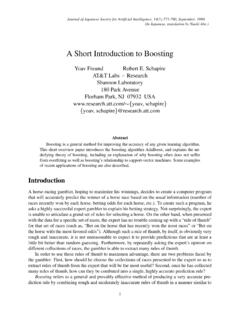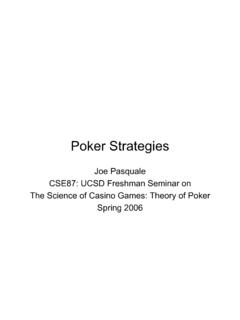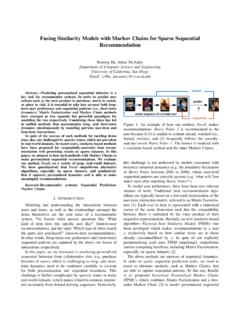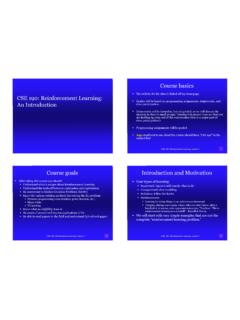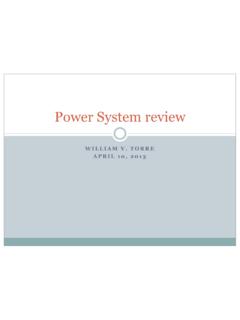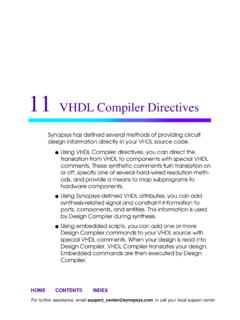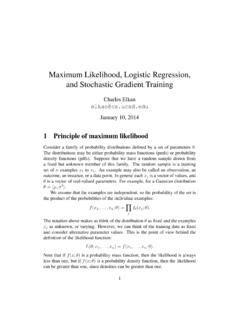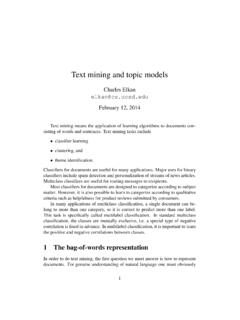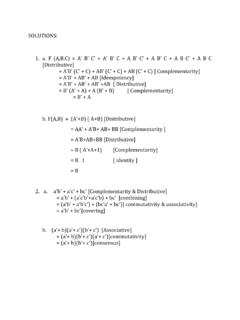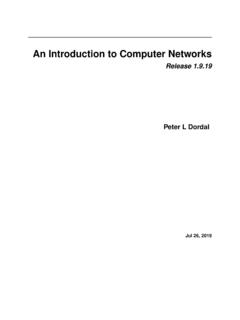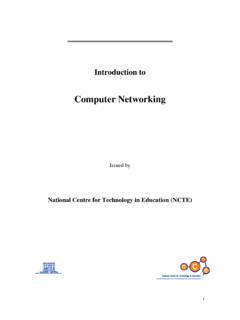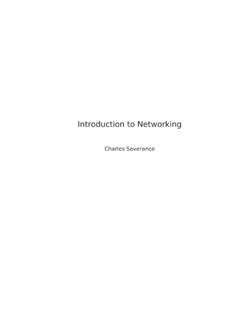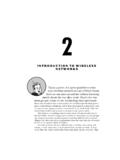Transcription of Lecture 1: Course Introduction - Home | Computer …
1 Lecture 1: Course IntroductionCSE 123: Computer NetworksStefan SavageCSE 123 Lecture 1: Course Introduction2 Overview for today Class overview Administrativa (who, what, where) Expected outcomes Structure of the Course Policies and procedures A brief overview of Computer networking High-level concepts An end-to-end exampleCourse instructors Stefan Savage Lecturer & taskmaster Web: ~savage E-mail: Office hours: Tu 4-5pm (or by appt) CSE 3106 Alex Rasmussen TA E-mail: Office hours: TBA Nima Nikzad TA E-mail: Office hours: TBACSE 120 Lecture 1: Course Introduction3 About meCSE 120 Lecture 1: Course Introduction4 I work at the intersection of networking , operating systems and Computer security Research Large-scale network measurement projects Routing behavior, WiFi performance, measurement tools Large-scale Internet attacks (worms/virus, bots, spam) and e-crime economics Policy National Science Foundation (CISE) NRC s Computer Science & Telecommunications Board ISAT advisory group for DARPA Industry Asta Networks (defunct anti-DDoS company) Netsift (UCSD-originated net company) -> Cisco Lots of consultingCourse info Discussion section: M 1-1:50 Center 109 There will be a discussion board (TBA) Course Web page Textbook: Peterson and Davie, Computer Networks: A systems Approach, Morgan Kaufmann, 5th Edition, ISBN 978-0123850591 CSE 120 Lecture 1: Course Introduction5 Alert!
2 No discussion section this Monday Tuesdays class is cancelled We next meet on Thursday the 29thCSE 120 Lecture 1: Course Introduction6 Expected Outcomes This Course willteach you the fundamentalsof Computer networks: Layering, signaling, framing, MAC, switching, routing, naming, Internetworking, congestion control, router design, etc. I will notteach you much about signals and coding Take an EE Course to learn about modulation, encoding, etc. on different hardware technologies Similarly, we will not cover Internet apps/services CSE124 covers application layer protocols, Web, etc. You can also pick up much of this on your ownCSE 123 Lecture 1: Course Introduction7 Prereqs CSE120 I will approve enrollment for students who have not taken it, But, you will be solely responsible for concepts and experience from the class ( , concurrency) Programming experience We will be assigning programming projects in C/C++ This Course will not teach you C.
3 The TAs will help, but you need to learn it on your own if you don t already know 123 Lecture 1: Course Introduction8 CSE 123 Lecture 1: Course Introduction9 CSE 123 Class Overview Course material taught through class lectures, textbook readings, and discussion sections Course assignments are Homework questions (based on Lecture and reading) 3 programming projects (two significant) Discussion sections are a forum for asking questions Lecture material and homework Additional networking topics Discussion board (TBA) The place to ask questions about Lecture , hw, projects, Written assignments are due at the beginningof class Regrades should be the exception Addition errors (happy), significant errors in grading (fine), nit picking/grade mongering (death to you) We reserve the right to completelyregrade your assignments All regrades go to TAs first No Cheating Cheating means not doing the assignment yourself Ok to talkwith other students about assignments outside of class No copying, no Google, etc.
4 If you re unsure, then ask Don t mess with the professor. He s a mean 120 Lecture 1: Course Introduction10 CSE 123 Lecture 1: Course Introduction11 Labs We will use the uAPE (B230) lab in the basement of the CSE/EBU3B building Linux running on Intel machines You can also use your home machine we will test on uAPE machines Be sure to test your projects there as wellCSE 123 Lecture 1: Course Introduction12 Exams Midterm Tentatively Tuesday, November 1st Covers first half of class Final Friday Dec 9th, 11:30-2:30 Covers second half of class + selected material from first part I will be explicit about the material covered No makeup exams Unless dire circumstances All tests closed book with crib sheet You can bring one double-sided page of notes to each exam to assist you in answering the questions Not a substitute for thinkingCSE 123 Lecture 1: Course Introduction13 Grading Homeworks: 20% Think of these collectively as a take-home midterm Midterm: 20% Final: 30% Projects: 30%CSE 123 Lecture 1.
5 Course Introduction14 How NotTo Pass CSE 123 Do not come to Lecture It s nice out, class is early, the slides are online, and the material is in the book anyway Lecture material is the basis for exams and directly relates to the projects I guarantee you I m more fun than the textbook Do not do the homework It s only 20% of the grade Excellent practice for the exams, and some homework problems are exercises for helping with the project 20% is actually a significant fraction of your grade (difference between an A and a C)CSE 123 Lecture 1: Course Introduction15 How NotTo Pass (2) Do not ask questions in Lecture , office hours, or email Professor is scary, I don t want to embarrass myself Asking questions is the best way to clarify Lecture material at the time it is being presented Office hours and email will help with homeworks, projects Wait until the last couple of days to start a project We ll have to do the crunch anyways, why do it early?
6 The projects cannot be done in the last couple of daysCSE 123 Lecture 1: Course Introduction16 Class Web Will serves many Course syllabus and schedule (updated as quarter progresses) Lecture slides Announcements Homework handouts Project informationCSE 123 Lecture 1: Course Introduction17 Questions Before we start the material, any questions about the class structure, contents, Simple Task Send information from one Computer to anotherCSE 123 Lecture 1: Course Introduction18 Link Endpoints are called hosts Could be Computer , iPod, cell phone, etc. The plumbing is called a link We don t care what the physical technology is: Ethernet, wireless, cellular, if hosts aren t directly connected? Routers/Switches: moves bits between links Circuit switching: guaranteed channel for a session (Telephone system) Packet switching: statistical multiplexing of independent pieces of data (Internet)CSE 123 Lecture 1: Course Introduction19 Measures of success How fast?
7 Bandwidthmeasured in bits per second Often talk about KBps or Mbps Bytes vs bits How long was the wait? Delay(one-way or round trip) measured in seconds (typically milliseconds) How efficiently? Overheadmeasured in bits or seconds or cycles Any mistakes? Error rate measured in terms of probability of a flipped bit (or corrupted packet)CSE 123 Lecture 1: Course Introduction20 How long to send a message? Transmit time T = M/R + D M = message size, R= bandwidth, D= Delay 10 Mbps Ethernet LAN (M=1KB) M/R=1ms, D ~=5us 155 Mbps cross country ATM link (M=1KB) M/R = 50us, D ~= 40-100ms Where are the bits in the mean time? In transit inside the network R*D is called the bandwidth delay product How many bits can be stored be stored in transit Colloquially, we say fill the pipe CSE 123 Lecture 1: Course Introduction21 But there s more to networking than sending Like what?
8 Sending bits to a particulardestination among many Sending a longmessage to a particular destination Detecting if there was an error Fixing the error Deciding how fast to send Making sure the message is kept private Etc, etc, : A Modular Approach Sub-divide the problem Break up functionality into distinct services( , reliable message delivery) Organized services into order series of layers Each layer relies on services from layer below Each layer exports services to layer above Interface between layers defines interaction Hides implementation details Layers can change without disturbing other layers Interface among peers in a layer is a protocol If peers speak same protocol, they can interoperateCSE 123 Lecture 1: Course Introduction23 TCP/IP Protocol StackHTTPTCPIPE thernetinterfaceHTTPTCPIPE thernetinterfaceIPIPE thernetinterfaceEthernetinterfaceSONET interfaceSONET interfacehosthostrouterrouterCSE 123 Lecture 1: Course Introduction24 Application LayerTransport LayerTransport LayerNetwork LayerNetwork LayerLink LayerLink LayerPhysical Layer(encoding on wires, light, radio, etc)Physical Layer(encoding on wires, light, radio, etc)Encapsulation via packet headersCSE 123 Lecture 1: Course Introduction25 HTTPTCPIPE thernetinterfaceHTTPTCPIPE thernetinterfacePayloadHeadersPutting this all together ROUGHLY, what happens when I click on a Web page from UCSD?
9 ComputerCSE 123 Lecture 1: Course Introduction26 InternetWeb request (HTTP) Turn click into HTTP requestGET : 123 Lecture 1: Course Introduction27 Name resolution (DNS) Where is s the address for Computer ( )Oh, you can find it at DNS server( )CSE 123 Lecture 1: Course Introduction28 Data transport (TCP) Break message into packets (TCP segments) Should be delivered reliably & in-orderGET : htt1 123 Lecture 1: Course Introduction29 Network Layer:Global Addressing Address each packet so it can traverse network and arrive at hostMy Computer ( ) ( )GET 123 Lecture 1: Course Introduction30 GoogleNetwork layer: packet routingCSE 123 Lecture 1: Course Introduction31 UCSDCENICS printQuestAT&T Each router forwards packet towards destinationLink Layer ( Ethernet) Break larger network message into individual frames Media Access Control (MAC) Can I send now?
10 Can I send now? Send frameReceiverCSE 123 Lecture 1: Course Introduction32 Physical Wireless Access PointEthernet switch/routerTo campus RadioDS/FH Radio(1-11 Mbps)Cat5 Cable (4 wires)100 Base TX 850nm MMF1000 BaseSX Ethernet1000 MbpsCSE 123 Lecture 1: Course Introduction33 CSE 123 Lecture 1: Course Introduction34 For Next Reminder No discussion section this Monday Tuesdays class is cancelled We next meet on Thursday the 29th Read Chapter 1 (excepting ) Go bookmark the Web page Drop now or plan to stick it out! Have a great weekend!
